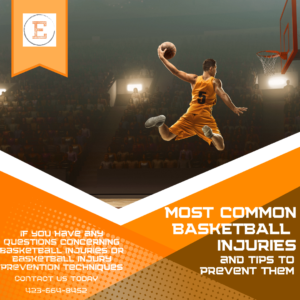“Winners are not people who do not fail, but people who never quit“-Anonymous
One of the most popular sports in America, especially among kids and young adults, is undoubtedly basketball. But the possibility of injury does not go away just because you love the game. There are injuries that occur whether the game is played casually or in a league, and some are more frequent than others.
Basketball injuries that involve the lower body the most frequently are those that do not involve the head. The following are some of the most typical:
Most common basketball injuries
1.Ankle sprains
- Basketball-related ankle and foot injuries account for nearly half of all injuries. Basketball players are vulnerable to injury for a variety of reasons, including “rolling” an ankle, awkward landings, and being stepped on.
- Depending on the severity, ICE (ice, compression, elevation) and physical therapy are used as treatments for ankle injuries, particularly ankle sprains.
2. Muscle strain
- Football players frequently suffer from muscle strains.
- The hamstring and quadriceps muscles at the front of the leg are most frequently affected by muscle strains, which are also referred to as pulled or torn muscles.
3. Knee ligament injuries
- Anterior cruciate ligament (ACL)
Most often discussed is certainly an ACL injury. One of the ligamentous bands that joins the thigh bone to the shin bone at the knee is the ACL. To return to play after an ACL tear, most people need surgery and several months of physical rehabilitation. - Meniscus
Every knee has two, and the ACL is frequently injured beside one of them. The meniscus serves as the knee joint’s cushion. Without them, the lower leg bones would be directly on top of the thigh bone, which would quickly become unpleasant. Meniscus injuries can be treated in a variety of ways, including ICE, surgery, and physical therapy. - Patella tendon
The most frequent knee injury is what is commonly referred to as jumper’s knee. The patella tendon, which joins your kneecap to your shin bone, becomes inflamed as a result. With the help of a physical therapist’s individualized exercise program, jumper’s knee may typically be recovered.
4. Jammed fingers
- In basketball, jammed fingers are extremely typical. They typically happen when the fingertip strikes the ball “head on” without bending. The finger may enlarge and become painful right away as a result of this motion.
- You can recover in as little as a week with buddy taping (taping the injured finger to the finger next to it) and ice. A trip to the doctor or a consultation with a physical therapist may be required, though, if discomfort or swelling persists.
5. Concussion
- Any brain injury that follows a blow to the head, neck, or body is referred to as a concussion. Concussions can happen in basketball, for instance, when a player collides with another player head-to-head, head-to-elbow, head-to-shoulder, etc., or when they strike their head on the hard gym floor.
- The player must wait at least five days before being cleared to play again once a concussion is detected. Some concussion recoveries might be sluggish and accompanied by persistent symptoms. A qualified physical therapist’s such as Elite Muscle Recovery concussion and vestibular rehabilitation is a fantastic option in these circumstances.
How can injuries be prevented?
- Maintain fitness
- Warm up and stretch.
- Hydrate
- Focus on Technique
- Ensure Appropriate Equipment
- An injured player’s symptoms must be completely gone before returning to play
If you have any questions concerning basketball injuries or basketball injury prevention techniques you can give us a call so that we can help you please contact us and we will get back to you as soon as possible visit our website at: https://elite-musclerecovery.com/
please call us: 📞423-664-8452



